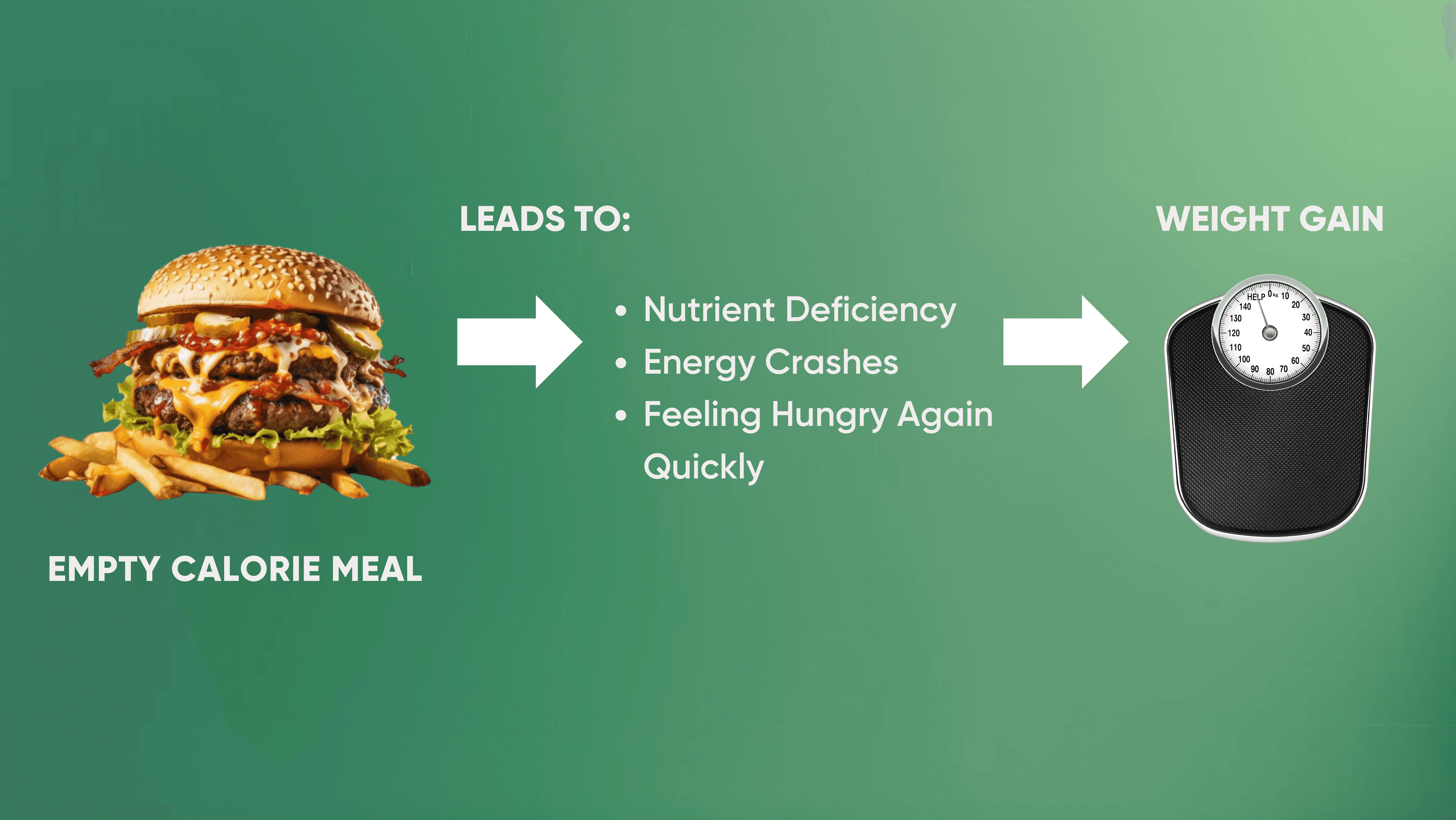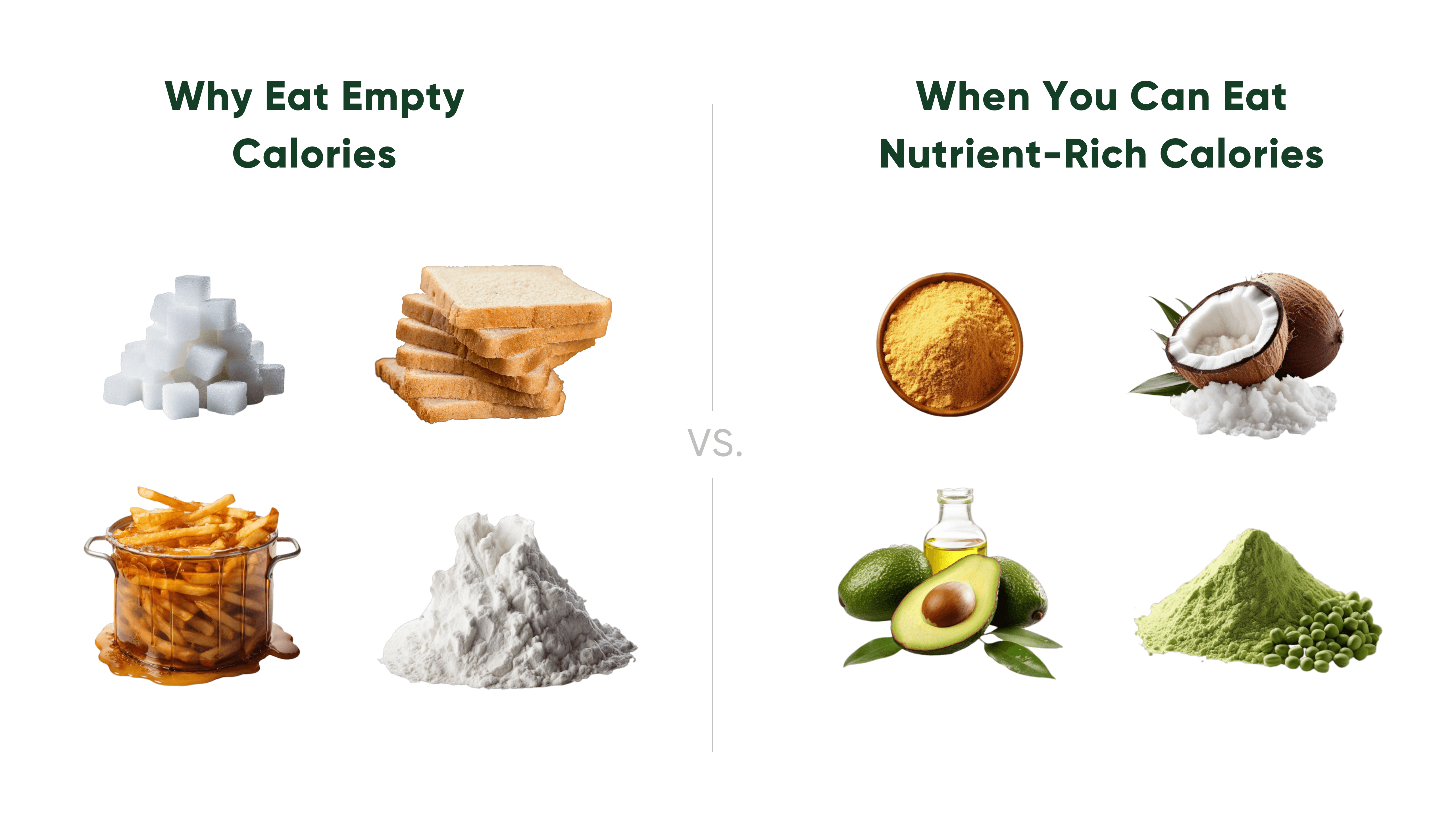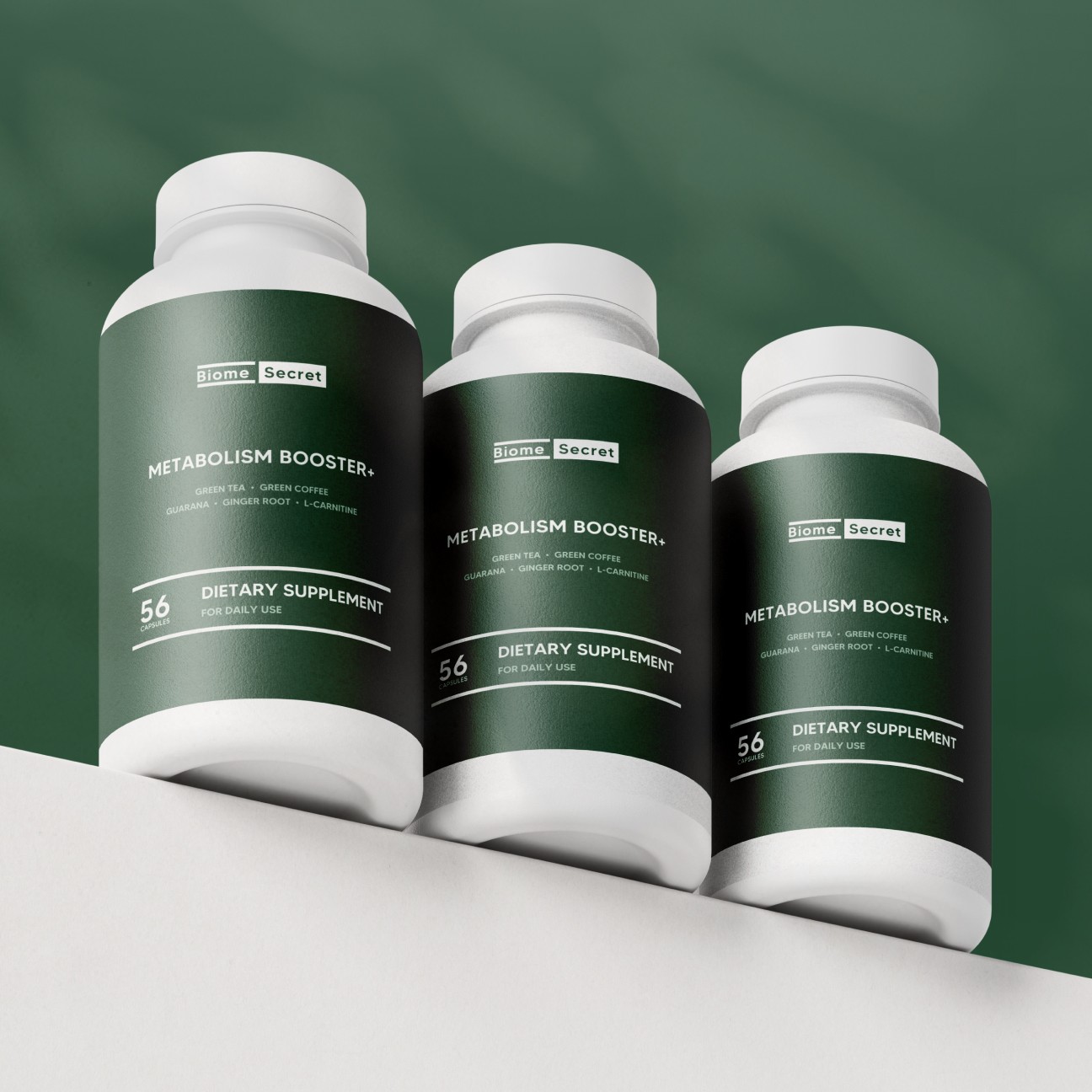Empty vs. Good Calories

By Olivia T.
Updated on
Jan 28, 2025
Share article:
Empty vs. Good Calories—learn the difference and why quality matters more than quantity.



Calorie Quality over Quantity: Good Calories vs. Empty Calories
When it comes to calories, it's more than just numbers; it's about the quality that fuels your body. Recognizing the difference between good calories, rich in nutrients, and their counterparts, empty calories, known for high energy but little nutrition, is key for a healthy diet. Think of good calories as the superheroes of your plate - they come with essential vitamins and minerals. On the opposite in the food world - empty calories. Despite being calorie-rich, they're essentially the junk food villains, providing little to no nutritional value. It's time to clear them from your plate and create space for the nutritional superheroes.
Good Calories - The Nutrient Density Effect
Step into a world where your food doesn't just taste good but also does good. We're talking about good calories - packed with vitamins, minerals, and fiber. These bites aren't just yummy; they're a health boost. The dietary reference intakes from the National Institute of Health recommend that adults obtain 45% to 65% of their total caloric intake from carbohydrates, 20% to 35% from healthy fats, and 10% to 35% from protein.

The breakdown of the essential components of nutrient-dense calories:
1. Carbohydrates: Essential for Energy
Carbohydrates: Essential for Energy. Carbohydrates serve as the primary source for the body, crucial in maintaining energy levels throughout the day. Once consumed, they break down into glucose, utilized by cells for various functions. Carbohydrates come in simple forms like sugars and complex forms like starches found in whole grains, fruits, and vegetables.
Simple Carbohydrates: Found in fruits (e.g., apples, bananas, berries) and dairy products (e.g., milk, yogurt).
Complex Carbohydrates: Present in whole grains (e.g., brown rice, quinoa, oats), vegetables (e.g., sweet potatoes, broccoli, spinach), and legumes (e.g., lentils, chickpeas, black beans).
2. Fats: Important for Brain and Cell Health
Fats are essential for the proper functioning of the brain, cell membranes, and various physiological processes. They provide a concentrated source of energy and aid in the absorption of fat-soluble vitamins (A, D, E, and K).
Healthy Monounsaturated Fats: Avocados, olive oil, and certain nuts (e.g., almonds, cashews).
Healthy Polyunsaturated Fats: Fatty fish (e.g., salmon, mackerel), flaxseeds, chia seeds, and walnuts.
3. Proteins: Crucial for Tissue Repair and Growth
Proteins are made up of amino acids, which are the building blocks of tissues and muscles. They play a vital role in tissue repair, growth, and maintenance.
Animal Sources: Chicken, turkey, beef, fish (e.g., salmon, tuna), eggs, and dairy products (e.g., milk, cheese, Greek yogurt).
Plant-Based Sources: Legumes (e.g., lentils, chickpeas), tofu, tempeh, edamame, nuts (e.g., almonds, walnuts), and seeds (e.g., chia seeds, sunflower seeds).
4. Vitamins and Minerals: Support Bodily Functions.
Vitamins and minerals are micronutrients that act as cofactors in enzymatic reactions, contribute to immune function, bone health, and assist in numerous metabolic processes. A well-rounded diet that includes a variety of fruits, vegetables, whole grains, and dairy products ensures an adequate intake of these essential micronutrients:
Micronutrient | |
|---|---|
Vitamin A | Found in sweet potatoes, carrots, spinach, kale, and eggs. |
Vitamin D | Obtained from fatty fish (e.g., salmon, trout), fortified dairy products, and exposure to sunlight. |
Vitamin E | Present in nuts (e.g., almonds, hazelnuts), seeds, and vegetable oils. |
Vitamin K | Found in leafy green vegetables (e.g., kale, broccoli, spinach). |
Calcium | Found in dairy products (e.g., milk, yogurt, cheese), fortified plant-based milk, and leafy greens (e.g., kale, bok choy). |
Iron | Obtained from red meat, poultry, fish, lentils, beans, and fortified cereals. |
Potassium | Present in bananas, oranges, potatoes, tomatoes, and beans. |
Zinc | Found in meat, dairy products, nuts, and whole grains. |
The nutrient-dense definition entails getting more nutrients per calorie consumed, crucial for energy and health without excess calorie intake (American Heart Association).
Empty Calories - Making Conscious Choices to Avoid Them
Empty calories, often referred to as 'nutritionally void' or 'empty' foods, are those that provide energy in the form of calories but offer little to no essential nutrients. These foods are typically high in sugars, fats, and refined carbohydrates, contributing to an excess of energy intake without delivering the necessary vitamins, minerals, and other vital components our bodies need for optimal health. Consuming a diet rich in empty calories can lead to nutritional deficiencies, energy crashes, various health issues, and weight gain. Understanding and identifying sources of empty calories is crucial for making informed dietary choices that prioritize nutritional value.

The breakdown of the components of empty calories:
1. Empty Carbohydrates: Providing Quick Energy, Lacking Nutrients.
Consuming too many empty carbs can contribute to energy spikes and crashes without delivering sustained nourishment. Examples of foods with empty carbohydrates include:
Sugary snacks: Candy, pastries, cookies, and other sweets.
Sodas: Regular soft drinks with high sugar content.
Processed foods: White bread, white rice, and certain breakfast cereals that are high in refined sugars.
2. Empty Fats: High in Unhealthy Lipids, Low in Nutritional Value.
Fats from highly processed snacks and fried foods often fall into the category of empty fats, high in unhealthy saturated and trans fats. Excessive consumption of empty fats can contribute to weight gain and negatively impact cardiovascular health. Examples of foods with empty fats include:
Highly processed snacks: Potato chips, deep-fried snacks, and commercially baked goods
Fried foods: Fast-food items like French fries and fried chicken.
Certain packaged snacks: Many commercially available baked goods and snack items often contain unhealthy trans fats.
3. Empty Proteins: Low-Quality Sources, Insufficient Nutrition.
Some protein sources, such as processed meats and certain fast-food options, can be considered empty proteins. While they may provide some protein content, they often lack the full range of essential amino acids and may come with added unhealthy ingredients. Examples of foods with empty proteins include:
Processed meats: Hot dogs, sausages, and some deli meats that are often high in sodium and preservatives.
Fast-food proteins: Certain burgers, nuggets, and other fast-food options that may contain low-quality meat and added unhealthy ingredients.

About 85% of your calories should come from nutrient-rich foods, as advised by thea Dietary Guidelines for Americans. This helps meet food group recommendations and maintain balance in your diet.
Taking Action: Swapping to Good Calories for Weight Loss
Transitioning to good calories can significantly impact weight loss and health. Adopting simple swap habits leads to better choices. Let's focus on transitioning from empty calories to more nutrient-dense, lower-calorie alternatives for effective weight loss.
Smart Meal Choices:
Instead of: Creamy Alfredo Pasta which is high in calories
Try: Biome Secret Meal Replacement Superfood Shake The only complete meal replacement that has 28 essential vitamins and minerals. Each serving contains 40g of protein, 12g of fiber, pre & probiotics, and enzymes. Quick, convenient and super delicious 380 calories option, ready in 30 seconds.

Smart Snacking Choices:
Instead of: Potato chips or other fried snacks
Try: Air-popped popcorn seasoned with herbs or a handful of mixed nuts for a satisfying crunch with healthy fats
Sweet Tooth Solutions:
Instead of: Sugary candies and sweets
Try: Fresh fruit or dried fruit with no added sugars, satisfying your sweet cravings with natural sweetness and added nutrients.
Beverage Upgrade:
Instead of: High-calorie, sugary desserts
Try: Sparkling water with a splash of natural fruit juice or infused water with slices of cucumber, lemon, or berries for a refreshing and low-calorie option.
Healthier Dessert Choices:
Instead of: High-calorie, sugary desserts
Try: Greek yogurt with a drizzle of honey and fresh berries, providing a balance of sweetness, protein, and beneficial nutrients.
Healthy Fast Food Swaps:
Instead of: Fried fast-food options
Try: Grilled chicken or veggie wraps, salads with lean protein, or a whole-grain sandwich with plenty of vegetables for a satisfying and lower-calorie meal.
Morning Beverage Upgrade:
Instead of: Sugary coffee drinks
Try: Black coffee or coffee with a splash of unsweetened almond milk, saving on added sugars and calories while still enjoying your coffee.
Smart Condiment Choices:
Instead of: High-calorie dressings and sauces
Try: Homemade vinaigrettes with olive oil and vinegar, or use Greek yogurt as a base for creamy dressings, adding flavor without excess calories.

Good Calories Over Quick Fixes and Empty Promises
As you navigate the landscape of good calories versus empty calories, remember that your choices resonate beyond taste buds, impacting your entire well-being, especially when it comes to weight loss. In a world filled with quick fixes and empty promises, the significance of choosing nutrient-dense options cannot be overstated.
Adopt the philosophy of quality in your life. Life is short - make every day count with the energy that good nutrition brings. And, importantly, obtaining nutrient-rich food is hassle-free; you don't need culinary expertise or extensive kitchen time. Easy, quick, and nutrient-rich solutions like Biome Secret Meal Replacement Superfood Shake are readily available to support your journey to nutrient-dense weight loss.
Calorie Quality over Quantity: Good Calories vs. Empty Calories
When it comes to calories, it's more than just numbers; it's about the quality that fuels your body. Recognizing the difference between good calories, rich in nutrients, and their counterparts, empty calories, known for high energy but little nutrition, is key for a healthy diet. Think of good calories as the superheroes of your plate - they come with essential vitamins and minerals. On the opposite in the food world - empty calories. Despite being calorie-rich, they're essentially the junk food villains, providing little to no nutritional value. It's time to clear them from your plate and create space for the nutritional superheroes.
Good Calories - The Nutrient Density Effect
Step into a world where your food doesn't just taste good but also does good. We're talking about good calories - packed with vitamins, minerals, and fiber. These bites aren't just yummy; they're a health boost. The dietary reference intakes from the National Institute of Health recommend that adults obtain 45% to 65% of their total caloric intake from carbohydrates, 20% to 35% from healthy fats, and 10% to 35% from protein.

The breakdown of the essential components of nutrient-dense calories:
1. Carbohydrates: Essential for Energy
Carbohydrates: Essential for Energy. Carbohydrates serve as the primary source for the body, crucial in maintaining energy levels throughout the day. Once consumed, they break down into glucose, utilized by cells for various functions. Carbohydrates come in simple forms like sugars and complex forms like starches found in whole grains, fruits, and vegetables.
Simple Carbohydrates: Found in fruits (e.g., apples, bananas, berries) and dairy products (e.g., milk, yogurt).
Complex Carbohydrates: Present in whole grains (e.g., brown rice, quinoa, oats), vegetables (e.g., sweet potatoes, broccoli, spinach), and legumes (e.g., lentils, chickpeas, black beans).
2. Fats: Important for Brain and Cell Health
Fats are essential for the proper functioning of the brain, cell membranes, and various physiological processes. They provide a concentrated source of energy and aid in the absorption of fat-soluble vitamins (A, D, E, and K).
Healthy Monounsaturated Fats: Avocados, olive oil, and certain nuts (e.g., almonds, cashews).
Healthy Polyunsaturated Fats: Fatty fish (e.g., salmon, mackerel), flaxseeds, chia seeds, and walnuts.
3. Proteins: Crucial for Tissue Repair and Growth
Proteins are made up of amino acids, which are the building blocks of tissues and muscles. They play a vital role in tissue repair, growth, and maintenance.
Animal Sources: Chicken, turkey, beef, fish (e.g., salmon, tuna), eggs, and dairy products (e.g., milk, cheese, Greek yogurt).
Plant-Based Sources: Legumes (e.g., lentils, chickpeas), tofu, tempeh, edamame, nuts (e.g., almonds, walnuts), and seeds (e.g., chia seeds, sunflower seeds).
4. Vitamins and Minerals: Support Bodily Functions.
Vitamins and minerals are micronutrients that act as cofactors in enzymatic reactions, contribute to immune function, bone health, and assist in numerous metabolic processes. A well-rounded diet that includes a variety of fruits, vegetables, whole grains, and dairy products ensures an adequate intake of these essential micronutrients:
Micronutrient | |
|---|---|
Vitamin A | Found in sweet potatoes, carrots, spinach, kale, and eggs. |
Vitamin D | Obtained from fatty fish (e.g., salmon, trout), fortified dairy products, and exposure to sunlight. |
Vitamin E | Present in nuts (e.g., almonds, hazelnuts), seeds, and vegetable oils. |
Vitamin K | Found in leafy green vegetables (e.g., kale, broccoli, spinach). |
Calcium | Found in dairy products (e.g., milk, yogurt, cheese), fortified plant-based milk, and leafy greens (e.g., kale, bok choy). |
Iron | Obtained from red meat, poultry, fish, lentils, beans, and fortified cereals. |
Potassium | Present in bananas, oranges, potatoes, tomatoes, and beans. |
Zinc | Found in meat, dairy products, nuts, and whole grains. |
The nutrient-dense definition entails getting more nutrients per calorie consumed, crucial for energy and health without excess calorie intake (American Heart Association).
Empty Calories - Making Conscious Choices to Avoid Them
Empty calories, often referred to as 'nutritionally void' or 'empty' foods, are those that provide energy in the form of calories but offer little to no essential nutrients. These foods are typically high in sugars, fats, and refined carbohydrates, contributing to an excess of energy intake without delivering the necessary vitamins, minerals, and other vital components our bodies need for optimal health. Consuming a diet rich in empty calories can lead to nutritional deficiencies, energy crashes, various health issues, and weight gain. Understanding and identifying sources of empty calories is crucial for making informed dietary choices that prioritize nutritional value.

The breakdown of the components of empty calories:
1. Empty Carbohydrates: Providing Quick Energy, Lacking Nutrients.
Consuming too many empty carbs can contribute to energy spikes and crashes without delivering sustained nourishment. Examples of foods with empty carbohydrates include:
Sugary snacks: Candy, pastries, cookies, and other sweets.
Sodas: Regular soft drinks with high sugar content.
Processed foods: White bread, white rice, and certain breakfast cereals that are high in refined sugars.
2. Empty Fats: High in Unhealthy Lipids, Low in Nutritional Value.
Fats from highly processed snacks and fried foods often fall into the category of empty fats, high in unhealthy saturated and trans fats. Excessive consumption of empty fats can contribute to weight gain and negatively impact cardiovascular health. Examples of foods with empty fats include:
Highly processed snacks: Potato chips, deep-fried snacks, and commercially baked goods
Fried foods: Fast-food items like French fries and fried chicken.
Certain packaged snacks: Many commercially available baked goods and snack items often contain unhealthy trans fats.
3. Empty Proteins: Low-Quality Sources, Insufficient Nutrition.
Some protein sources, such as processed meats and certain fast-food options, can be considered empty proteins. While they may provide some protein content, they often lack the full range of essential amino acids and may come with added unhealthy ingredients. Examples of foods with empty proteins include:
Processed meats: Hot dogs, sausages, and some deli meats that are often high in sodium and preservatives.
Fast-food proteins: Certain burgers, nuggets, and other fast-food options that may contain low-quality meat and added unhealthy ingredients.

About 85% of your calories should come from nutrient-rich foods, as advised by thea Dietary Guidelines for Americans. This helps meet food group recommendations and maintain balance in your diet.
Taking Action: Swapping to Good Calories for Weight Loss
Transitioning to good calories can significantly impact weight loss and health. Adopting simple swap habits leads to better choices. Let's focus on transitioning from empty calories to more nutrient-dense, lower-calorie alternatives for effective weight loss.
Smart Meal Choices:
Instead of: Creamy Alfredo Pasta which is high in calories
Try: Biome Secret Meal Replacement Superfood Shake The only complete meal replacement that has 28 essential vitamins and minerals. Each serving contains 40g of protein, 12g of fiber, pre & probiotics, and enzymes. Quick, convenient and super delicious 380 calories option, ready in 30 seconds.

Smart Snacking Choices:
Instead of: Potato chips or other fried snacks
Try: Air-popped popcorn seasoned with herbs or a handful of mixed nuts for a satisfying crunch with healthy fats
Sweet Tooth Solutions:
Instead of: Sugary candies and sweets
Try: Fresh fruit or dried fruit with no added sugars, satisfying your sweet cravings with natural sweetness and added nutrients.
Beverage Upgrade:
Instead of: High-calorie, sugary desserts
Try: Sparkling water with a splash of natural fruit juice or infused water with slices of cucumber, lemon, or berries for a refreshing and low-calorie option.
Healthier Dessert Choices:
Instead of: High-calorie, sugary desserts
Try: Greek yogurt with a drizzle of honey and fresh berries, providing a balance of sweetness, protein, and beneficial nutrients.
Healthy Fast Food Swaps:
Instead of: Fried fast-food options
Try: Grilled chicken or veggie wraps, salads with lean protein, or a whole-grain sandwich with plenty of vegetables for a satisfying and lower-calorie meal.
Morning Beverage Upgrade:
Instead of: Sugary coffee drinks
Try: Black coffee or coffee with a splash of unsweetened almond milk, saving on added sugars and calories while still enjoying your coffee.
Smart Condiment Choices:
Instead of: High-calorie dressings and sauces
Try: Homemade vinaigrettes with olive oil and vinegar, or use Greek yogurt as a base for creamy dressings, adding flavor without excess calories.

Good Calories Over Quick Fixes and Empty Promises
As you navigate the landscape of good calories versus empty calories, remember that your choices resonate beyond taste buds, impacting your entire well-being, especially when it comes to weight loss. In a world filled with quick fixes and empty promises, the significance of choosing nutrient-dense options cannot be overstated.
Adopt the philosophy of quality in your life. Life is short - make every day count with the energy that good nutrition brings. And, importantly, obtaining nutrient-rich food is hassle-free; you don't need culinary expertise or extensive kitchen time. Easy, quick, and nutrient-rich solutions like Biome Secret Meal Replacement Superfood Shake are readily available to support your journey to nutrient-dense weight loss.



Lose Weight Now!
Your go-to for effective weight loss. Curb cravings, boost metabolism, stay full longer.
Sign up for the Biome Secret Newsletter and Secure Your Offer
DISCLAIMER
The statements on this page have not been evaluated by the Food and Drug Administration (FDA). Our products are not intended to diagnose, treat, cure, or prevent any disease. Consult with a healthcare professional before starting any dietary or wellness program. The mention of any external brands on our site does not imply their endorsement of our products. We independently select and share these brands to complement our offerings without any implied partnerships or endorsements.
© Biome Secret 2025
Sign up for the Biome Secret Newsletter and Secure Your Offer
DISCLAIMER
The statements on this page have not been evaluated by the Food and Drug Administration (FDA). Our products are not intended to diagnose, treat, cure, or prevent any disease. Consult with a healthcare professional before starting any dietary or wellness program. The mention of any external brands on our site does not imply their endorsement of our products. We independently select and share these brands to complement our offerings without any implied partnerships or endorsements.
© Biome Secret 2025
Sign up for the Biome Secret Newsletter and Secure Your Offer
DISCLAIMER
The statements on this page have not been evaluated by the Food and Drug Administration (FDA). Our products are not intended to diagnose, treat, cure, or prevent any disease. Consult with a healthcare professional before starting any dietary or wellness program. The mention of any external brands on our site does not imply their endorsement of our products. We independently select and share these brands to complement our offerings without any implied partnerships or endorsements.
© Biome Secret 2025


